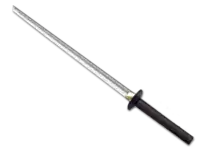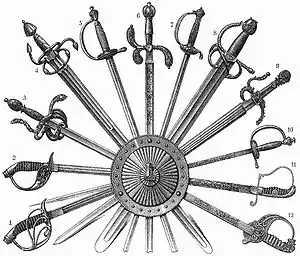Ninjatō
The ninjatō (忍者刀), ninjaken (忍者剣), or shinobigatana (忍刀),[2] are allegedly the preferred weapon that the shinobi of feudal Japan carried. It is portrayed by modern ninjutsu practitioners (including Masaaki Hatsumi[3] and Stephen K. Hayes) as the weapon of the ninja, and is prominently featured in popular culture.[4] Replicas of this sword are displayed at the Ninja Museum of Igaryu,[5] established in the mid-1960s.[6][7][8]
| Ninjatō / Shinobigatana | |
|---|---|
 A computer image sample depiction of the ninjatō | |
| Type | Short sword (single-edge) |
| Place of origin | Japan |
| Specifications | |
| Mass | ~0.42 kilograms (0.93 lb)[1] |
| Length | ~48 centimetres (19 in)[1] |
Historically, there is no physical evidence for the existence of this "katana-like short sword legendarily used by ninja" before the 20th century,[9] though it is believed that the designs demonstrated by alleged replicas are based on the design of wakizashi or chokutō swords or the swords associated with ashigaru.[1]
History
Because of the lack of any physical evidence or antique swords from the Sengoku period to the Edo period (16th to 19th century) matching the description of the ninjatō,[1] the history of the weapon can only be reliably chronicled from the 20th century onwards.
- 1956: The first known photograph of a straight-blade ninjatō was featured in a 26-page Japanese booklet entitled Ninjutsu by Heishichirō Okuse.[10][11]
- 1964: The Ninja Museum of Igaryu in Japan, which houses replicas of the sword, is established.[6] That same year, the swords appeared in Shinobi no Mono Kirigakure Saizō (忍びの者 霧隠才蔵) and Shinobi no Mono Zoku Kirigakure Saizō (忍びの者 続・霧隠才蔵), the 4th and 5th entries in the Japanese jidaigeki movie series Shinobi no Mono, released in theaters in Japan.
- 1973: Ads selling newly manufactured and imported ninja swords appear in the American magazine Black Belt.[12]
- 1981: Books containing references to the sword written by Masaaki Hatsumi, the founder of the Bujinkan,[3] and Stephen K. Hayes,[4] an American who studied under Hatsumi in 1975,[13] are published.
- 1983: The first Hollywood film to feature the ninjatō, Revenge of the Ninja, is released in theaters.
- 1984: The first American television production to feature these swords, The Master, is broadcast on NBC.
Appearance
.jpg.webp)
The ninjatō is typically depicted as being a short sword, often portrayed as having a straight blade (similar to that of a shikomizue)[14] with a square guard.[1] Usually of a length "less than 60 cm", the rest of the sword is comparatively "thick, heavy and straight". Despite the disputed historical existence of the ninjato,[9] Hayes claims to describe it in detail, and suggests that the typical description of the ninjatō could be due to ninja having to forge their own blades from slabs of steel or iron with the cutting edge being ground on a stone, with straight blades being easier to form than the much more refined curved traditional Japanese sword. His second possible reason for ninjatō being described as a straight-bladed, rather short sword could be that the ninja were emulating one of the patron Buddhist deities of ninja families, Fudo Myo-oh, who is depicted brandishing a straight-bladed short sword similar to a chokutō.[15] Stephen Turnbull, a historian specializing in the military history of Japan indicates of historical ninja: "The most important ninja weapon was his sword. This was the standard Japanese fighting sword or katana ... for convenience the ninja would choose a blade that was shorter and straighter than usual."[16]
Usage
Due to the lack of historical evidence regarding the existence of the ninjatō, techniques for usage in a martial context are largely speculative. When used in film and stage, ninjatō are depicted as being shorter than a katana with a straight blade but they are utilized in a "nearly identical" manner as the katana.[17] Books and other written materials have described a number of possible ways to use the sword including "fast draw techniques centered around drawing the sword and cutting as a simultaneous defensive or attacking action",[18] with "a thrust fencing technique",[19] and with a "reverse grip".[20]
The scabbards were often said to have been used for various purposes such as a respiration pipe (snorkel) in underwater activities or for secretly overhearing conversations.[19][21] The scabbard is also said to have been longer than the blade of the ninjatō in order to hide various objects such as chemicals used to blind pursuers.[22][23] The tsuba (hand guard) of the ninjato is often described as being larger than average and square instead of the much more common round tsuba. One theory on the ninjatō tsuba size and shape is that it was used as a tool, the sword would be leaned against a wall and ninja would use the tsuba as a step to extend his normal reach, the sword would then be retrieved by pulling it up by the sageo (saya cord).[24][25]
References
- Dorling Kindersley (2010-03-15). Knives and Swords. Penguin Books. p. 281. ISBN 9780756663308. Retrieved December 22, 2011.
- Lewis, Peter (1988). Art of the Ninja. Gallery Books. p. 53,122. ISBN 9780831704773. Retrieved December 26, 2011.
- Hatsumi, Masaaki (1981). Ninjutsu: History and Tradition. Unique Publications. p. 13,93,102–103. ISBN 9780865680272. Retrieved December 27, 2011.
- Hayes, Stephen K. (1981). The Ninja and their Secret Fighting Art. C.E. Tuttle Co. p. 89. ISBN 9780804813747. Retrieved January 5, 2012.
editions:lzi6xoPi0SAC.
- "Japan National Tourism Organization". Retrieved May 21, 2017.
- Black Belt Magazine December 1966, p. 20 (1966-12-01). Photo of ninja sword display in the Iga-Ueno Ninja Museum. Retrieved January 6, 2012.
- "Ueno City Tourist Association". Archived from the original on December 9, 2018. Retrieved May 20, 2017.
- "Tour of Iga". Retrieved May 20, 2017.
- Boughn, Jenn Zuko (2006). Stage combat: fisticuffs, stunts, and swordplay for theater and film. Skyhorse Publishing. p. 192. ISBN 9781581158250. Retrieved January 5, 2012.
- Okuse, Heishichirō (1956). Ninjutsu. Osaka, Kinki Nippon Tetsudō.
- Turnbull, Stephen (2018). Ninja: Unmasking the Myth. Frontline Books. ISBN 978-1473850422.
- Black Belt Magazine November 1973, p. 61 (November 1973). Ninja Sword ad. Retrieved January 6, 2012.
- "Stephen K. Hayes Biography". Archived from the original on December 26, 2011. Retrieved January 6, 2012.
- Seishinkai Bujutsu. "Concealed and Trick Weapons". Retrieved January 5, 2012.
- Lore of the Shinobi Warrior, Stephen Hayes. Black Belt Communications, Nov 1, 1989P.22.
- Turnbull, Stephen (2003). Ninja Ad 1460-1650. Osprey Publishing. p. 18. ISBN 978-1-84176-525-9. Retrieved January 5, 2012.
- Boughn, Jenn Zuko (2006). Stage combat: fisticuffs, stunts, and swordplay for theater and film. Skyhorse Publishing. p. 156. ISBN 9781581158250. Retrieved December 22, 2011.
- Hatsumi, Masaaki (1981). Ninjutsu: History and Tradition. Unique Publications. p. 13. ISBN 9780865680272. Retrieved January 11, 2012.
- Virtual Museum of Traditional Japanese Arts. "Shinobi Gatana ("Ninja" swords)". Archived from the original on December 9, 2018. Retrieved December 29, 2011.
- Hayes, Stephen K. (1983). Ninja: Warrior Path of Togakure. Ohara Publications, Inc. pp. 96–97. ISBN 9780897500906. Retrieved January 11, 2012.
- Scandiffio, Laura (2003). The Martial Arts Book, Laura Scandiffio, Nicolas Debon, Annick Press, Feb 1, 2003 P.40. ISBN 9781550377767. Retrieved 2014-07-24 – via Google Books.
- Draeger, Donn F (1989). Ninjutsu: The Art of Invisibility, Donn F. Draeger, Tuttle Publishing, Mar 15, 1992 P.60. ISBN 9780804815970. Retrieved 2014-07-24 – via Google Books.
- Levy, Joel (2008). Ninja: The Shadow Warrior, Joel Levy, Sterling Publishing Company, Inc., Aug 5, 2008 P.59. ISBN 9781402763137. Retrieved 2014-07-24 – via Google Books.
- Kim, Ashida (1998). Secrets of the Ninja, Ashida Kim, Citadel Press, 1981, P.60. ISBN 9780806508665. Retrieved 2014-07-24 – via Google Books.
- Draeger, Donn F (1989). Ninjutsu: The Art of Invisibility, Donn F. Draeger, Tuttle Publishing, Mar 15, 1992, P.60. ISBN 9780804815970. Retrieved 2014-07-24 – via Google Books.
External links
| Wikimedia Commons has media related to Ninjatō. |
